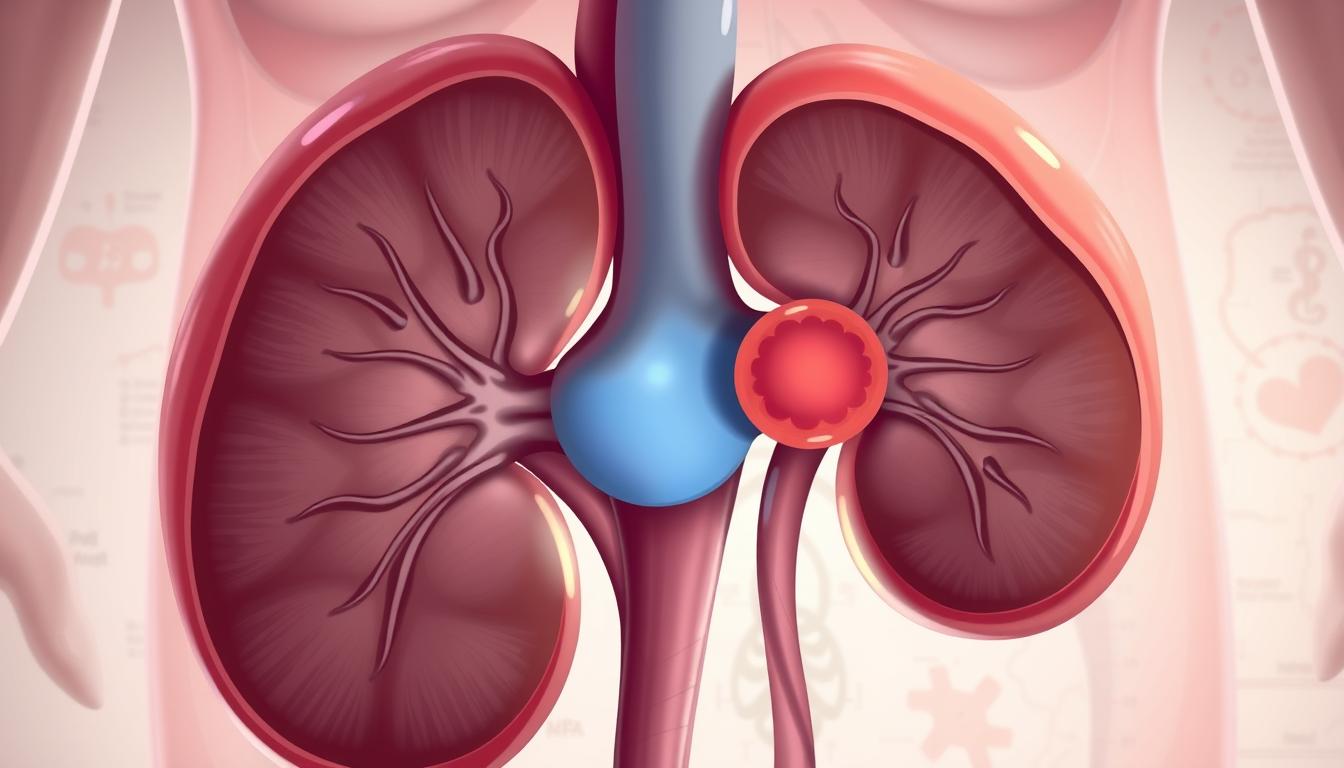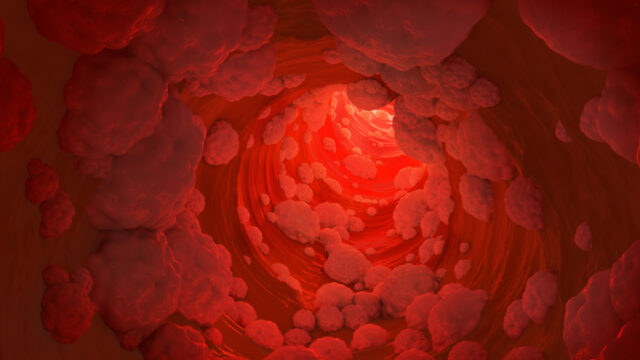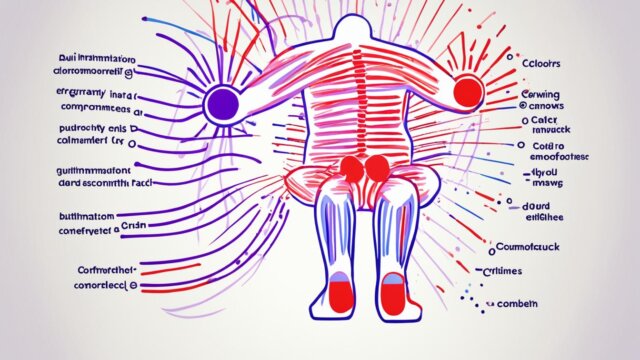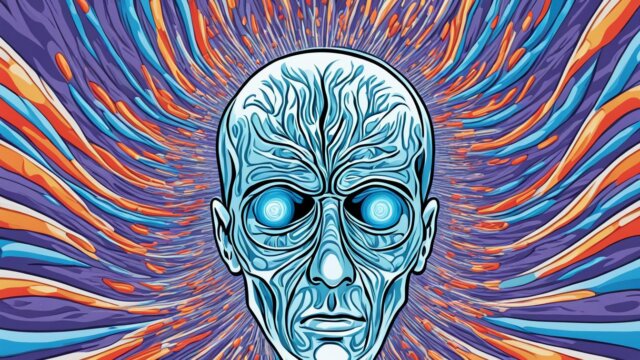FTC disclaimer: This post may contains affiliate links and we will be compensated if you click on a link and make a purchase.
Did you know Wilms tumor, also known as nephroblastoma, is the most common kidney cancer in kids? It usually hits children between 3 and 4 years old. It becomes less common after age 5, but can still affect older kids and adults.
Wilms tumor often happens in just one kidney. But, it can also be in both kidneys at the same time. The good news is, we’ve made big steps in finding and treating Wilms tumor. This has really helped kids with this disease.
Key Takeaways
- Wilms tumor is the most common type of kidney cancer in children.
- Wilms tumor mainly affects children aged 3 to 4, but can occur in older children and adults.
- Wilms tumor can affect one or both kidneys simultaneously.
- Significant progress in diagnosis and treatment has improved the prognosis for Wilms tumor.
- Symptoms of Wilms tumor can vary, and some children may not show any symptoms.
What is Wilms Tumor (Nephroblastoma)?
Wilms tumor, also known as nephroblastoma, is a common pediatric kidney cancer. It is the fourth most common childhood cancer. This rare embryonal neoplasm comes from immature nephroblastic cells in the kidney. It is a renal malignancy in nephro-oncology.
Overview
Wilms tumor is the most common kidney cancer in kids, making up 7% of all pediatric cancers. About 500 kids in the United States get diagnosed with it every year.
Symptoms
Symptoms of Wilms tumor vary, and some kids may not show any at all. The most common sign is a painless abdominal mass, seen in 60% of kids. Other symptoms include hematuria (blood in the urine), hypertension (high blood pressure), fever, and anemia. Cancer cells often spread to the lungs and can affect other areas like the brain and bones.
If you see any concerning symptoms in your child, get medical help right away. Early diagnosis and treatment are key for the best results in managing Wilms tumor.
Key Facts about Wilms Tumor | Data |
|---|---|
Percentage of pediatric cancers | 7% |
Annual diagnoses in the US | 500 |
Presenting symptom: Abdominal mass | 60% |
Bilateral (both kidneys affected) | 5-10% |
Favorable histology | 90% |
Overall cure rate | 80-90% |
Wilms tumor is serious, but with quick diagnosis and right treatment, 80% to 90% of kids can be cured. This shows good results when treated by expert nephro-oncology teams.

“Wilms tumor is the most common type of kidney cancer in children, and with early detection and proper treatment, the majority of children can be cured.”
Causes and Risk Factors
The exact cause of Wilms tumor is still a mystery. It’s thought to be linked to genetic changes in the genitourinary tract. Genes like WT1, CTNNB1, and WTX are often found in kids with Wilms tumor. Also, kids with conditions like aniridia, hemihypertrophy, and syndromes like WAGR, Denys-Drash, and Beckwith-Wiedemann are at higher risk.
Genetic Factors
Genetic changes play a big role in Wilms tumor. Mutations in WT1, CTNNB1, and WTX genes increase the risk. About one to two percent of kids with Wilms tumor have a family history of it.
Congenital Conditions
Kids with certain conditions are more likely to get Wilms tumor. These include aniridia, hemihypertrophy, and syndromes like WAGR, Denys-Drash, and Beckwith-Wiedemann. Kids with Beckwith-Wiedemann syndrome have a 5 percent chance of getting Wilms tumor. Those with Denys-Drash syndrome face a much higher risk, so removing the kidney is often recommended.
Congenital Condition | Risk of Wilms Tumor |
|---|---|
WAGR Syndrome | 30-50% chance |
Beckwith-Wiedemann Syndrome | 5% risk |
Aniridia | Increased risk |
Hemihypertrophy | Increased risk |
Wilms tumor is the most common kidney cancer in kids. It mostly affects kids under five. In the U.S., African Americans have a slightly higher risk, while Asian Americans have the lowest. Girls are also at a slightly higher risk than boys.
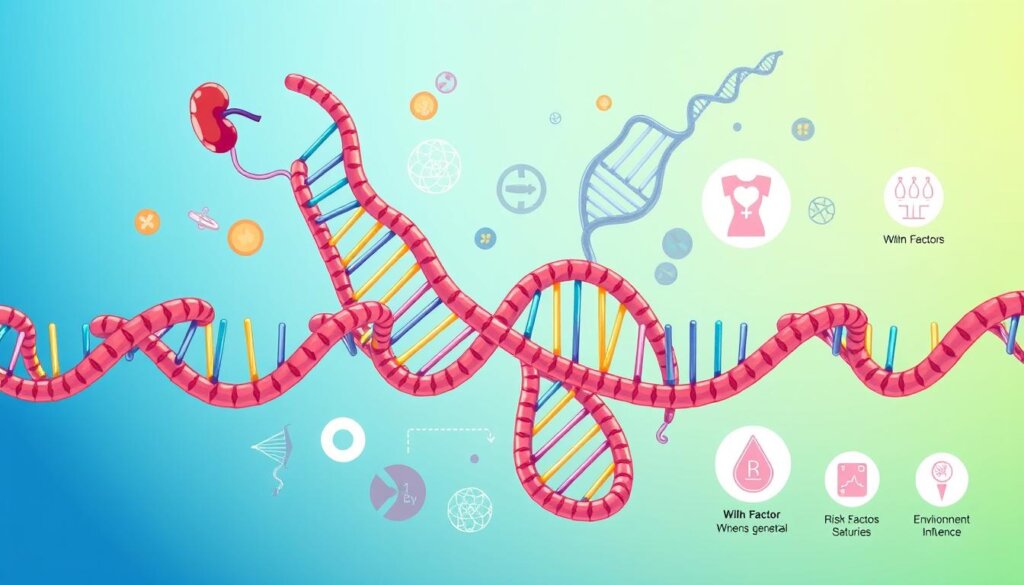
“Approximately one in ten children with a particular syndrome developing the tumor.”
Nephroblastoma: Diagnosis and Evaluation
Diagnosing Wilms tumor, also known as nephroblastoma, is key for young patients. It starts with a physical examination and imaging tests. These tests check the tumor’s size, location, and how far it has spread.
Physical Examination
The healthcare provider may feel a mass or swelling in the child’s abdomen during the exam. This is a clue for diagnosing Wilms tumor.
Imaging Tests
Healthcare providers use ultrasound, CT scan, and MRI to assess the tumor. These tests are vital for planning the right treatment. A chest X-ray also checks if the cancer has spread to the lungs.
- Ultrasound is often the first test, giving detailed info about the tumor and kidney.
- CT scan and MRI offer more detailed info about the tumor’s size and spread.
- Chest X-ray checks if the cancer has spread to the lungs.
These tests are crucial for finding the best treatment for each child with Wilms tumor.

“Diagnosing Wilms tumor early and accurately is essential for providing the best possible care and improving outcomes for these young patients.”
Treatment Options for Wilms Tumor
Wilms tumor treatment often includes surgery, chemotherapy, and sometimes radiation therapy. Surgery, like a nephrectomy, is usually the first step. Sometimes, a partial nephrectomy is done to save part of the kidney.
Surgery
Surgery, like a nephrectomy, is the main treatment for Wilms tumor. Sometimes, a partial nephrectomy is done to save part of the kidney. The choice of surgery depends on the tumor’s stage, its type, and the child’s health and age.
Chemotherapy
After surgery, chemotherapy is used to kill any cancer cells left. The chemotherapy used can change based on the tumor’s stage and type. Drugs like actinomycin D, vincristine, and doxorubicin are common.
Radiation Therapy
In some cases, radiation therapy is added to the treatment plan. This is especially true for advanced-stage tumors or those with certain genetic factors. Proton therapy, a targeted form of radiation, is also an option for some children.
The treatment plan for each child is made just for them. It considers the tumor’s stage, type, and the child’s health and how they respond to treatment. The goal is to treat the tumor effectively while avoiding long-term side effects.
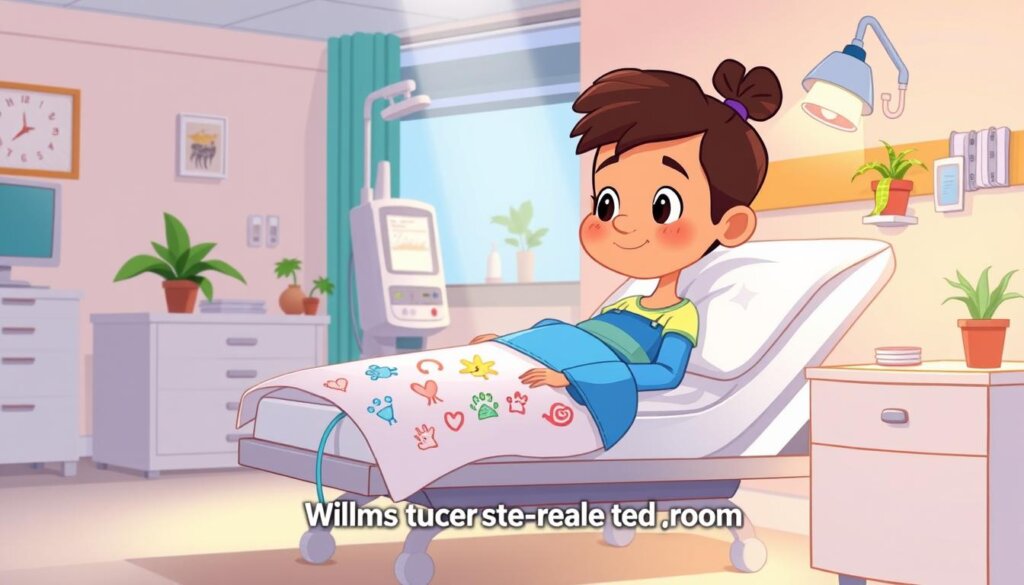
“The 5-year relative survival rate for children under 20 years with Wilms tumor is 93%.”
Prognosis and Survival Rates
The 5-year survival rate for kids with Wilms tumor is about 92% in the U.S.. But, the outcome can change based on the cancer’s stage, how it looks under a microscope, and how well it responds to treatment. Most kids get better with quick medical help and strong treatment.
About 40% of Wilms tumors are stage I. This means the tumor is only in the kidney and hasn’t spread. Stage II makes up about 20% of cases, where cancer has grown but was removed surgically. Stage III is also 20%, with tumors left in the abdomen after surgery.
Stage IV is about 10% of cases, showing cancer spread to distant organs like lungs or liver. Stage V is rare, with tumors in both kidneys at diagnosis.
Tumor Stage | Favorable Histology | Focal Anaplastic | Diffuse Anaplastic |
|---|---|---|---|
I | 95% – 100% | 85% – 90% | 75% – 80% |
II | 95% – 100% | 80% – 85% | 80% – 85% |
III | 95% – 100% | 75% – 90% | 50% – 70% |
IV | 85% – 90% | 70% – 75% | 30% – 45% |
V | 95% – 100% | 95% – 100% | 65% – 70% |
It’s key to keep up with follow-up care. This helps watch for long-term side effects and aims for the best outcome for the child.
“With prompt medical attention and aggressive therapy, the majority of children with Wilms tumor have a good prognosis.”
Late Effects and Cancer Survivorship
While treatment for Wilms tumor is often very effective, some kids may face long-term side effects. These can include kidney problems, heart issues, lung troubles, and bone and muscle issues. Survivors might also have a higher chance of getting another cancer later.
The Cancer Survivorship Program at CHOP offers ongoing care for Wilms tumor survivors. They do regular checks to find side effects early and make treatment plans for each person. Their goal is to help survivors live well, dealing with the challenges they face after treatment.
Late Effect | Potential Impact |
|---|---|
Kidney Problems | Proteinuria, hypertension, and potential kidney failure |
Heart Conditions | Affecting up to one-quarter of children, with girls at greater risk |
Lung Issues | Radiation pneumonitis and pulmonary fibrosis |
Bone and Muscle | Scoliosis or underdeveloped muscles |
Liver Problems | Hepatomegaly and sinusoidal obstruction syndrome |
Reproductive Challenges | Premature delivery, infertility, or early menopause |
Second Cancer Risk | Influenced by genetic factors or previous treatments |
Healthcare teams closely watch Wilms tumor survivors and tailor their care. This helps reduce long-term risks and ensures the best outcomes. This detailed approach is key to supporting Wilms tumor patients for life, helping them live fully after their treatment.
Nephroblastoma in Special Syndromes
Wilms tumor, also known as nephroblastoma, is not just a single condition. It can also be part of certain genetic syndromes. These include WAGR syndrome, Denys-Drash syndrome, and Beckwith-Wiedemann syndrome. Understanding these special syndromes is key for early detection and treatment of Wilms tumor in kids.
WAGR Syndrome
WAGR syndrome is a rare genetic condition. It combines Wilms tumor, aniridia (absence of the iris), genitourinary anomalies, and intellectual disabilities. Kids with WAGR syndrome face a high risk of getting Wilms tumor, with about 50% of them developing it.
It’s important to watch these kids closely. This way, any Wilms tumor can be caught early and treated on time.
Denys-Drash Syndrome
Denys-Drash syndrome is another genetic condition linked to Wilms tumor. It’s marked by Wilms tumor, kidney disease, and male pseudohermaphroditism. Genetic mutations, like those in the WT1 gene, raise the risk of Wilms tumor in these patients.
Children with Denys-Drash syndrome need special care and close monitoring. This is to catch Wilms tumor early and treat it effectively.
Beckwith-Wiedemann Syndrome
Beckwith-Wiedemann syndrome is a genetic condition that increases the risk of Wilms tumor. It also includes hemihypertrophy, pancreatic enlargement, and macroglossia. Kids with this syndrome need to be watched closely for signs of Wilms tumor, as the risk is 5-10%.
Quick action is key to ensure the best outcomes for these children.
It’s vital for healthcare providers to know about the links between Wilms tumor and these genetic syndromes. Early detection and comprehensive care can greatly improve the prognosis and quality of life for these children.
Syndrome | Key Features | Wilms Tumor Risk |
|---|---|---|
WAGR Syndrome | Wilms tumor, aniridia, genitourinary anomalies, intellectual disabilities | Approximately 50% risk |
Denys-Drash Syndrome | Wilms tumor, kidney disease, male pseudohermaphroditism | High risk due to genetic mutations |
Beckwith-Wiedemann Syndrome | Hemihypertrophy, pancreatic enlargement, macroglossia | 5-10% risk |
“Recognizing the associations between Wilms tumor and these genetic syndromes is essential for healthcare providers. Early identification and comprehensive management of children with these conditions can significantly improve their overall prognosis and quality of life.”
Multidisciplinary Care Approach
At renowned pediatric hospitals, kids with Wilms tumor get care from a multidisciplinary team. This team includes surgeons, oncologists, urologists, radiologists, radiation oncologists, pathologists, and nurse practitioners. They work together to make a treatment plan that fits the child’s needs.
This team provides comprehensive, coordinated treatment and support for the child and their family. They make sure all parts of the child’s care are covered.
The multidisciplinary approach to Wilms tumor treatment is key. It brings together different medical specialties for better patient results. Surgeons handle the surgery, and oncologists manage the chemotherapy.
Urologists, radiologists, and radiation oncologists work together to plan radiation therapy, if it’s needed. Pathologists help by giving information about the tumor, which guides treatment. Nurse practitioners act as the main contact for the patient and family, making sure care flows smoothly.
Thanks to the Wilms tumor treatment team, kids get the best comprehensive and personalized care possible. This team effort has been proven to improve outcomes and make kids with Wilms tumor feel better.
“The collaborative effort of our multidisciplinary team ensures that every aspect of a child’s Wilms tumor treatment is carefully considered and tailored to their unique needs.”
Preventive Measures and Screening
While Wilms tumor can’t be stopped, kids with certain conditions may get regular checks. Doctors might suggest kidney ultrasounds to watch for tumors. This can’t stop Wilms tumor but can find it early, helping with treatment.
Wilms tumor is the most common kidney cancer in kids. Symptoms include belly pain, fever, and blood in urine. In some cases, it affects both kidneys or spreads.
About 10%-15% of Wilms tumors are caused by genetic changes. Also, 1%-2% of kids with Wilms tumor have family members with it. Genes like REST and WT1 are linked to it.
For kids at high risk, doctors suggest kidney ultrasounds to catch problems early. This can lead to better treatment and outcomes.
Screening Test | Purpose |
|---|---|
Kidney Ultrasound | To monitor for abnormalities or the development of a tumor |
Urinalysis | To check for blood in the urine, which can indicate bleeding in or around the kidneys |
Complete Blood Count (CBC) | To check for anemia and ensure normal blood levels before chemotherapy |
Blood Chemistry Tests (BUN, Creatinine) | To evaluate kidney function and detect abnormalities indicating potential cancer |
Imaging Tests (Ultrasound, X-ray, CT, MRI, PET) | For diagnosis, staging, and monitoring the spread of Wilms tumor |
In conclusion, while we can’t prevent most childhood cancers, early detection through screening can improve treatment chances.
“Childhood kidney tumours are considered urgent cases, indicating the severity of the condition in children.”
Conclusion
Wilms tumor, also known as nephroblastoma, is the most common type of pediatric kidney cancer. It usually affects children between 3 and 5 years old. The exact cause is still a mystery, but some genetic factors and birth defects can raise the risk.
Early detection and a team approach to treatment have made a big difference. This often includes surgery, chemotherapy, and sometimes radiation. With the right care, most kids with Wilms tumor have a bright future.
As we learn more about Wilms tumor and pediatric kidney cancer, we see the value of early detection. We also know the importance of comprehensive treatment and support for survivors. By focusing on these, we can give kids with this condition the best chance at a healthy life.
FAQ
What is Wilms tumor (nephroblastoma)?
Wilms tumor, also known as nephroblastoma, is a common kidney cancer in kids. It usually happens in children aged 3 to 5.
What are the symptoms of Wilms tumor?
Symptoms can vary. Some kids show no signs. Common signs include a belly mass, swelling, and pain. Fever, blood in urine, anemia, and high blood pressure are also symptoms.
What causes Wilms tumor?
The exact cause is not known. But it’s linked to genetic changes in the genitourinary tract. Genes like WT1, CTNNB1, and WTX increase the risk.
How is Wilms tumor diagnosed?
Doctors use a physical exam and imaging tests like ultrasound, CT scan, and MRI. These tests check the tumor’s size, location, and spread.
What are the treatment options for Wilms tumor?
Treatment includes surgery, chemotherapy, and sometimes radiation. Surgery removes the affected kidney first. Chemotherapy kills remaining cancer cells. Radiation is added in some cases.
What is the prognosis for children with Wilms tumor?
The 5-year survival rate is about 92% in the U.S. But, it depends on the cancer stage, type, and treatment response.
What are the potential long-term effects of Wilms tumor treatment?
Some kids face complications years later. This can be due to radiation or chemotherapy. CHOP’s Cancer Survivorship Program offers ongoing care and support.
Can Wilms tumor be associated with genetic syndromes?
Yes, it can be part of syndromes like WAGR, Denys-Drash, and Beckwith-Wiedemann. Kids with these syndromes have a higher risk and need special care.
How is Wilms tumor treated at CHOP?
At CHOP, a team of experts treats Wilms tumor. This team includes surgeons, oncologists, and more. They tailor the treatment to each child’s needs.
Can Wilms tumor be prevented?
No, but kids at risk can get regular check-ups. Healthcare providers might suggest kidney ultrasounds to watch for tumors.
